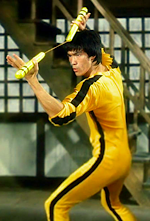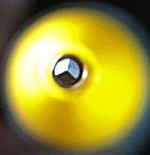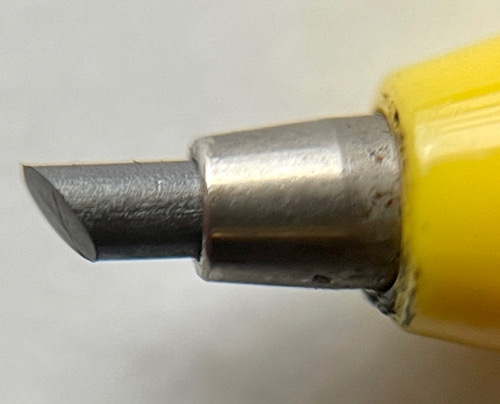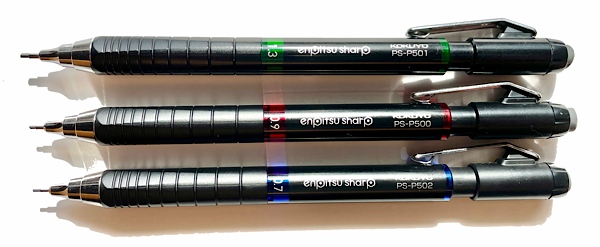1.3mm mechanical pencils
In the past I sketched almost exclusively in ink. But for these past several years most of my sketches have been in pencil. As the previous page indicates, I did return to ink sketching for while with the fude nib fountain pen but later gravitated back to the pencil.
My pencil style is basically the same as my ink style; I tend to use the tip of the pencil to get black lines rather than shade with the side of the pencil. I like crisp dark strokes of varying widths and lots of hatching with the white space showing between the hatch lines.
Here are some random pencil sketches on an index card from a recent subway commute. I was quickly sketching whatever happened to be in front of my eyes for even a few moments before it vanished, and didn't bother to place the subjects in different parts of the card.
When I sketch with a pencil, all the restraints are removed, and it feels like the gloves have come off and I am free to make the best possible lines without thinking about it.
I am sketching for pleasure after all, and not making professional illustrations which may require brush and ink as well as more concentration at a desk rather than standing on a moving subway.
Lately most of my pencil sketches have been done with a 2mm mechanical pencil because I love the expressive line variation I get with it as I vary the pressure. As a matter of fact the results can look very similar to brush and ink.
It might come as a surprise that one can get such a range of line widths from a stiff pencil, but apparently it comes from the softness of the paper which comes into more contact with the pencil as you bear down, giving you a wider line. The broad strokes will also be blacker, and the fine strokers lighter, which enhances the effect.
But I never actually get a 2mm wide line even with a 2mm lead because of the angle at which I hold a pencil. I would have to hold the pencil perpendicular to the paper in order to get that.
The first photo shows a lead perpendicular to the paper. The middle photo shows a lead which was worn to a natural point from the angle at which I hold the pencil. The photo on the right shows a lead which was sharpened with a lead pointer for very fine lines.
Of course this naturally worn appearance would vary with the user since we all hold our pencils at different angles, and we may or may not have the habit of rotating the pencil as we use it. This 2mm lead will give me very broad lines as well as relatively fine lines (not super fine lines). The "swirlies" above were drawn with this tip.
If you don't rotate your pencil and hold it at a low angle, you may be able to wear down the tip to get a very broad line which is even wider than the diameter of the lead itself.
And you can also get a thin line at the tip. The photo above is a 2mm lead.
I am not against lead pointers; they let me get a variety of line widths. And if you sharpen a thick lead, that thickness will support the tip and protect it from breaking. With a lead pointer you can use thicker leads for even a small sketch.
These days I prefer to not carry a lead pointer in my pocket or try to use one on a crowded subway, and I think that 1.3mm is as thick as you can go with a naturally pointed tip.
And for some reason, a naturally pointed 1.3mm pencil lead gives me a darker, more crisp line that a naturally pointed 2.0mm lead.
This pencil model is nice to hold and extremely simple; no clip, and nothing comes apart. You put lead into it by means of a small hole at the end of the barrel.
The leads can fall back out if you hold the pencil with the point up, and that was my biggest complaint about this model because it happened often.
Or so I assumed until I was going through some old sketchbooks from eight years ago. On one page I came across this little sketch with a note:
How soon we forget. I have no recollection of writing these words (this happens too frequently and is the reason I keep a journal). And now eight years later I was making the same discovery.
I was hoping to find a pencil with an eraser and a clip this time, and which did not leak leads from a hole in the end of the barrel.
Enter the Staedtler
I came across this 1.3mm pencil by Staedtler. It's the 771 model and has a three facet barrel and a white eraser that extends by rotating it, similar to what I have on my 0.7mm Faber-Castell Grip Plus
and has a three facet barrel and a white eraser that extends by rotating it, similar to what I have on my 0.7mm Faber-Castell Grip Plus .
.
As a matter of fact, the erasers on these two pencils as well as the entire eraser units are identical in size and are even interchangeable.
I had read some reviews which mentioned that the pencil came in a package with extra leads and erasers.
My pencil came from Amazon here in Japan with no packaging -- not even shrink wrap -- and was actually rubber-banded to another package that came in the same Amazon box.
I can't complain since I only wanted the pencil, and would throw away the packaging. Still, the extra leads and erasers would have been nice.
But 1.3mm leads are easy enough to find, and if I ever need a replacement eraser, there are a few brands of Japanese eraser refills that fit perfectly, including the Tombow Mono One.
I've always been partial to Staedtler products since the name has a common origin with my own family name Stutler.
And the way it's pronounced in Japanese is very close to the way my own name is pronounced. So its almost like having tools with my name imprinted on them.
Apparently Staedtler in Germany discontinued the yellow model, but Staedtler in Japan continued to produce it and expanded the line to include a white model.
Both the yellow and white models are the same price on Amazon Japan. As I type this, they are each 741 yen or roughly seven US dollars at the current exchange rates. As I've said before, stuff made in Japan also costs less in Japan.
I took a long hard look at the white one mainly because yellow has always been my least favorite color. But this pencil is only available in yellow or white, and white is not even a color (in my opinion).
After researching a little more, I found out that this is pencil design is considered iconic, and that the yellow color is a big part of that.
Speaking of iconic, it reminds me of the costume which Bruce Lee wore when he was filming his final movie Game of Death.
 Bruce Lee in Game of Death
Credit: Golden Harvest
Bruce Lee in Game of Death
Credit: Golden Harvest
So I started to find the yellow design with black stripes more appealing. At least it's not boring, and it should be easy to find if I drop it.
Although it's a fat pencil, the triangle barrel makes it comfortable to hold. Still, this triangle design is more pronounced than my other triangle pencils such as the Kokuyo 1.3mm which is so slim that the fingers and thumb touch each other when you hold it and the 0.7mm Faber-Castell Grip Plus which has such a subtle triangle rubber grip that it is almost hexagonal.
If you constantly rotate this pencil when you draw, its position will be pretty much restricted to three angles, and the point can become three facets which is pretty cool.
 Unexpected feature
Unexpected feature
of a triangle pencil
A three-sided barrel will give you predictable line width variation because it's easy to locate the broad tip and fine tip.
If your index finger is resting on a flat surface of the barrel and you are getting broad lines, rest it on a ridge and make a down stroke; you'll get a fine line.
Of course, as I mentioned earlier, if you hold the pencil without rotating, the tip will wear down at a consistent angle and become incredibly broad with access to a very fine line as well.
 Broad surface with sharp chisel edge at the top
Broad surface with sharp chisel edge at the top
But I am a habitual pencil rotater, and in the end I must admit that his pencil is a bit awkward for me because the fat triangle shape makes it hard to rotate the pencil quickly.
It's such a fun looking pencil, I hope I can warm up to it someday.
The Kokuyo enpitsu sharp
I also found a Japanese 1.3 mechanical pencil that comes with a twist-out eraser and round barrel. It has a grip which transitions from hexagonal at the tip to round towards the barrel.
This is the Kokuyo enpitsu sharp in the 1.3mm size. They have three sizes (.7mm, .9mm and 1.3mm) that are differentiated by the color on the barrel. The 1.3mm is dark green which is my favorite color, so I didn't have to come to terms with a new color, and the barrel is not as fat.
This pencil comes in two versions, one with a translucent green plastic barrel and rubber grip, and a more expensive version with translucent green accents and a metal grip. I didn't know which I would prefer so I bought both. And although I like the feel of the more expensive one a little better, they both perform the same.
I admit I find the translucent green exciting, so I prefer the looks of the cheaper version which has more green visible. It has a rubber grip which can be helpful if pencils fly out of your hand.
Both pencils have black erasers which twist out of the end, and they are so convenient. I love soft plastic white erasers, but I wasn't so sure if I would like a black eraser because I feared it would leave black marks on the paper. But it turned out to be just like a white eraser in softness and effectiveness, and left no marks.
The advantage of a black eraser is that it will never look dirty, which is nice when it is visible in the shirt pocket. White erasers typically look dirty after use.
These pencils came with a few 1.3mm leads inside, and they were 2B which is exactly what I wanted for dark expressive lines. To insert new leads you just pull out the clip and eraser unit. The clip is metal and will flex to fit your pocket.
The metal tube or sleeve which shields the lead in the tip of the pencil will retract into the body when you are finished with it, so it will not get caught in your pocket. The yellow Staedtler above also has this feature, and it is very important for a lot of people including me.
I have been sketching fellow commuters on the evening subway with these pencils. Here are a few photos of some of those sketches which I snapped immediately after I produced them while I was still on the subway.
These sketches also appear on my Instagram page (@russellstutler). I find myself uploading more sketches to Instagram these days because it's so much easier than sitting down to fiddle with HTML and add them to this web site. My Instagram page is geared towards my students who often watch me sketch, so a lot of the text is in Japanese.
The jotter in most of these photos is the Oxford At-Hand Note Card Case which I describe on page 4 of this section. I prefer this jotter when I'm drawing partial poses such as heads or hands rather than full standing poses.
which I describe on page 4 of this section. I prefer this jotter when I'm drawing partial poses such as heads or hands rather than full standing poses.
These were all sketched with the metal grip version of the pencil. Both of these pencils are great for sketching, and I can rotate them freely as I draw and get a wide variety of line widths and shades of black, and I don't need to carry a lead pointer.
I later bought the other two sizes 0.7mm and 0.9mm as well.

There is also a cheaper model called the Kokuyo Enpitsu Sharp Type S which comes in various colors.
which comes in various colors.
I have noticed that a lot of Kokuyo's mechanical pencils are called enpitsu sharp which is rather confusing. Enpitsu is simply the Japanese name for pencil and sharp is short for sharp pencil which is what mechanical pencils are called in Japan.
Return of the short sketching pencil
In the hot months when I wear more casual clothing to work, I encounter a unique pencil problem. The casual shirts I've gotten recently here in Tokyo all have shorter shirt pockets than what I had in the past, and they will not take a full size pencil. Much of the pencil sticks out of the pocket, and I can't use the clip because it doesn't reach far enough. So the pencil is destined to fall out repeatedly.
My way around this problem was to go back to my original triangle green Kokuyo 1.3mm pencil. Some versions of this model come with a plastic clip which can be slid to any spot on the barrel.
This kept the pencil from falling out of the pocket, but it was not exactly an elegant solution because the pencil still stuck way out from my short pocket, which could get in the way. So I cut it down to about 115mm to keep in my front pants pocket, fully expecting to fail and ruin the pencil. Fortunately it was easier than I had anticipated because it is made of soft material which can be cut with a cheap craft knife (a.k.a cutter knife).
Now when I slide the clip on, this becomes a very portable and versatile sketching pencil. I don't need the clip if I'm keeping the pencil in my pants front pocket, but it's easy to slide the clip back on if I want it.
After I cut the pencil down, it hit me that I should have taken photos of the process. So I did it again with my magenta 0.9mm Kokuyo (click on the photo to see a slightly bigger version for details).
First, I cut down the outer shell at about the second zero in P1000. Then I cut the same amount off the plastic inner tube. Then I inserted the black plastic end piece into the shortened inner tube. The tube originally had square openings for the spring-tabs on the black end piece, but I don't think they are necessary; friction seems to hold it in place.
After I discovered how easy it is to disassemble these pencils, (just unscrew the black cone tip) I went ahead and plugged up the hole on that black end piece with white craft glue (PVA) so the leads won't fall out anymore.
By the way, before I attempted this modification, I had to clean up the rubbery surface of these pencils which had become gummy and sticky over several years of going unused in a pen cup. First I rubbed them down with a tissue paper and lighter fluid (naphtha) then I followed up with a tissue paper and ethanol.
A long time ago I always carried this ugly little pencil in my front jeans pocket. It was a sawed-off, sanded-down wood mechanical pencil by Ohto with 0.9mm leads and was my absolute favorite for nearly twenty years until it stopped working and wouldn't take any more attempts to repair it.
When I measured my two new sawed-off Kokuyo pencils, they were exactly the same length as this old retired one. It's nice to once again have short sketching pencils with thick leads.
But these pencils are so fun and so inexpensive, that I went ahead and bought a few more of the dark green 1.3mm version and have kept them at their full original length.
Note about Amazon links: If you click on a link and buy something at Amazon, a few pennies per dollar goes into my Amazon account, so instead of letting Amazon keep it all, you can pry a few pennies from their fingers make them share it with me. Any other vendor links I may put on this website are just for your convenience.